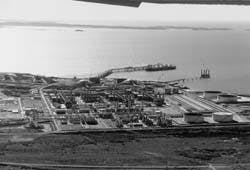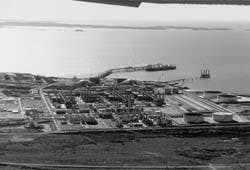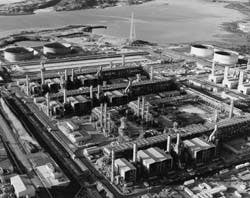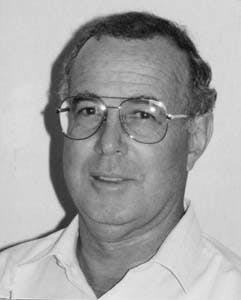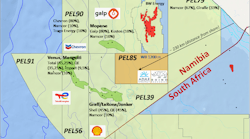W.J. Brehaut, M.J. Concannon
Woodside Offshore Petroleum Pty.
Karratha, Australia
The North West Shelf gas project, Karratha, Western Australia, has successfully carried out a three-train LNG plant debottlenecking to increase capacity from 6.9 million metric tons/year (mty) to more than 7.5 mty.
The two major constraints targeted by the project were the CO2-removal column and the main refrigerant compressor drivers. Replacement of the original trays by structured packing in the Sulfinol absorber columns and a change of solvent composition has cured foaming problems and increased gas-treating capacity.
Installation of a performance-improvement package known as Advanced Technology Parts (ATP) has effectively uprated the gas-turbine drivers of the refrigerant compressors from GE Frame 5B to 5C. An increase in turbine power of 9% has been achieved.
Together with modifications to the precooling propane compressors and other plant equipment, the LNG capacity of the plant has increased to 118% of design, an increase of 10 LNG cargoes/year, while retaining the same operating flexibility for different ambient temperatures.
In 1996, the integrated North West Shelf gas project will have the capacity to deliver some 18 million metric tons (mt) of LNG, domestic gas, LPG, and condensate. The $48 million (Australian) debottlenecking of the three LNG trains was completed on schedule and below budget to realize an 8% increase in LNG production.
Woodside facilities
Woodside Offshore Petroleum Pty Ltd. is responsible for the design, construction, and operation of the LNG facilities of the North West Shelf project on behalf of the six joint venture participants: Woodside Petroleum Ltd., Shell Development (Australia) Ltd., BHP Petroleum (NWS) Pty. Ltd., BP Developments (Australia) Ltd., Chevron Asiatic Ltd., and Japan Australia LNG (MIMI) Pty. Ltd.
The integrated onshore and offshore project cost $12 billion (Australian); the first LNG cargo left for Japan in 1989.
The process plant facilities are located in Western Australia near the town of Karratha, 1,500 km (932 miles) north of Perth and some 7,000 km from Japan. In this cyclone-prone area, all production facilities as well as support services such as company housing are designed accordingly.
Process-plant facilities consist of three LNG trains, each with a capacity of at least 2.5 million mty, as well as domestic gas trains, condensate stabilization units, and LPG extraction facilities (Fig. 1).
Production of domestic gas first started in 1984, and there has been a build up in delivery of LNG and other products to reach the forecast system capacity total for 1996 of some 18 million mt.
The LNG plant is the worlds tenth base-load facility and is unique with its extensive use of air-cooling and also the 4 x 26 mw (ISO) gas-turbine drivers for the refrigeration compressors.
Shells Sulfinol process is used to remove carbon dioxide, followed by a three-vessel molecular sieve dehydration unit and a mercury-removal unit.
The propane/mixed refrigerant liquefaction process incorporates an end-flash stage with flash gas being recovered for fuel by an 11-mw (ISO) gas turbine-driven compressor. Two fractionation trains provide C2/C3 refrigerant makeup, and LNG is stored in four tanks, each 65,000 cu m capacity.
Debottlenecking
The debottlenecking project was undertaken to increase the capacity of each LNG train from 2.3 to at least 2.5 million mty.
Capacity constraints in LNG production had been the foaming problems in the Sulfinol absorber and the output power limitations of the refrigerant compressor drivers.
The Sulfinol process was designed to treat feed gas containing 4% (vol) CO2 at a rate of 110% of design to the LNG specification of 100 ppm (mol) (maximum).
After startup, the CO2 absorber column exhibited a high foaming tendency resulting in reduced LNG production from upsets and unsteady operation. A change in Sulfinol formulation allowed some increase in capacity but also increased the hydrocarbons co-absorbed and entrained with the fat Sulfinol feed to the regenerator, resulting in losses totaling some 200 mt/day with the vented CO2 gas for the three LNG trains.
The Sulfinol unit was modified by the replacement of the 55 absorber HI-FI trays with 2 x 12-m sections of Sulzer Mellapak 250x structured packing (Fig. 2). This allowed a move to a more aqueous Sulfinol formulation (35% water) with lower hydrocarbon co-absorption and losses.
Review of the refrigerant compressors drivers found the effects of aging (fouling, wear) to have been less severe than predicted by the vendor (Fig. 3).
Availability of Advanced Technology Parts (ATP) for the gas turbines (effective upgrade from GE Frame 5B to Frame 5C) made an increase in power of 8% feasible.
ATP include two-vane first stage nozzles, thermal-barrier coated combustion chamber liners, splash plate cross-fire tubes, directionally solidified high-pressure wheel buckets, and new high-pressure/low-pressure thrust bearings. Application of such a package allows an uprating increase in the turbine-firing temperature of some 20 C.
The process basis for the debottlenecking involved shifting a part of the mixed refrigerant load to the propane cycle and redistributing the natural-gas precooling load between the high/medium/low pressure propane cycles.
This led to the need to re-wheel the rotor of the low-pressure compressor. With the increased LNG train capacity, there was also the need to shift some of the end-flash load to the LNG boil-off gas compressor system.
The engineering activities of debottlenecking each LNG train involved installation of ATP in the gas turbines and the new rotor in the low-pressure propane compressor along with other plant modifications, including larger pump impellers and control valve and piping changes.
With these, capacity of the LNG trains was expected to reach 117% of design (Fig. 4).
The total debottlenecking project was estimated at $56 million (Australian; $7 million for the gas treating modifications and $49 million for upgrading the three LNG trains).
LNG Train 2 was debottlenecked as part of a major maintenance shutdown in October 1993, Train 1 in 1994, and Train 3 in 1995.
Success
The gas-treating capacity has increased to throughputs approaching 125% of design by the application of structured packing and a change in Sulfinol composition (from 50/30/20 to 50/15/35 di-isopropylamine/Sulfolane/water, % weight).
The Mellapak structured packing allows natural gas feed rates which are 10% higher than the debottlenecked LNG production. The pressure drop over the absorber has been decreased by 1 bar, and there is less entrainment of Sulfinol with the treated gas going to the downstream dehydration unit.
The modifications cost $7 million and reduced hydrocarbon emissions by 50% to around 30 mt/day/LNG train, representing a significant environmental and cost benefit.
Following installation of ATP, the gas turbines were tested under vendor supervision at maximum power, being full speed with exhaust gas temperature control. The before and after results of actual power and efficiency were compared against the nominal figures for the 26.1 mw (ISO) rating.
The ATP repowering shows an average of 9.0% improvement in gas turbine shaft power output (Fig. 3) together with an average turbine efficiency improvement of more than 1.0%. Performance monitoring has shown the aging effect to be less than expected and has emphasized the importance of regular water-washing of the axial combustion air compressor in order to maintain high efficiency and gas turbine power.
Capacity performance of the debottlenecked LNG trains has been comprehensively tested over the full range of ambient temperatures. The performance has exceeded the debottlenecking design by approximately 1% for mid to high-range temperatures and by 5% at lower temperatures (Fig. 4).
The debottlenecked LNG trains exhibit a similar operating flexibility for different ambient temperatures as the original trains.
The LNG train performance has confirmed earlier estimates that post-debottlenecking, multiple constraints arise and limit further increases in the technical maximum capacity of each train. At high ambient temperatures air-cooling capacity limits production, while at low ambient temperatures, further increases are limited by the capacity of the end-flash and boil-off systems, as well as a low temperature (metallurgy) constraint on the low pressure propane compressor.
Beyond these limits, the refrigerant compressor power again becomes the bottleneck.
The repowering of gas turbines and other modifications cost $41 million, including $14 million to install ATP in the gas turbines and $10 million for the new low-pressure propane compressor rotors.
As operator of the North West Shelf gas project on behalf of the joint-venture partners, Woodside Petroleum has realized a major $48 million debottlenecking of three LNG trains according to schedule and within budget.
The technology success of this project has seen the plant design capacity increase by some 8% equivalent to an additional 10 LNG cargoes/year.
Acknowledgment
The authors wish to thank the joint-venture participants of the North West Shelf gas project and the management of Woodside Offshore Petroleum Pty. Ltd. for permission to publish this article.
Based on a presentation to 11th International Conference & Exhibition on LNG, Birmingham, July 3-6, 1995.
The Authors
W.J. Brehaut is technical manager, seconded from Shell International Petroleum Ltd., of Woodside Offshore Petroleum Ltd.s gas plant at Karratha, W.A.. He holds bachelor (1966) and doctorate (1969) degrees in chemical engineering from the University of Canterbury, New Zealand. He is a chartered engineer, fellow of the Institute of Chemical Engineers and of the Institute of Petroleum, and a member of the Institution of Professional Engineers of New Zealand.
M.J. Concannon is chief process engineer at Woodside Offshore Petroleum Ltd.s gas plant at Karratha. He has also served as a process engineer at BP Oils refinery, Kwinana, W.A.
Concannon holds a bachelors degree (1984) in chemical engineering from the University of Melbourne and is a chartered engineer, and a member of the Institute of Chemical Engineers of Australia.
Copyright 1996 Oil & Gas Journal. All Rights Reserved.
